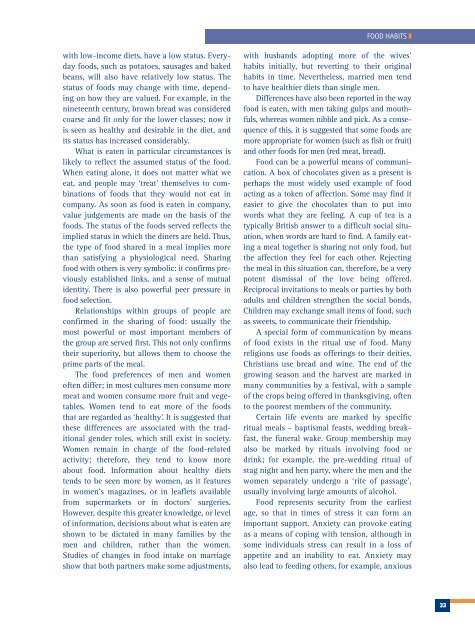Human Nutrition
Human Nutrition
Human Nutrition
Create successful ePaper yourself
Turn your PDF publications into a flip-book with our unique Google optimized e-Paper software.
FOOD HABITS ❚<br />
with low-income diets, have a low status. Everyday<br />
foods, such as potatoes, sausages and baked<br />
beans, will also have relatively low status. The<br />
status of foods may change with time, depending<br />
on how they are valued. For example, in the<br />
nineteenth century, brown bread was considered<br />
coarse and fit only for the lower classes; now it<br />
is seen as healthy and desirable in the diet, and<br />
its status has increased considerably.<br />
What is eaten in particular circumstances is<br />
likely to reflect the assumed status of the food.<br />
When eating alone, it does not matter what we<br />
eat, and people may ‘treat’ themselves to combinations<br />
of foods that they would not eat in<br />
company. As soon as food is eaten in company,<br />
value judgements are made on the basis of the<br />
foods. The status of the foods served reflects the<br />
implied status in which the diners are held. Thus,<br />
the type of food shared in a meal implies more<br />
than satisfying a physiological need. Sharing<br />
food with others is very symbolic: it confirms previously<br />
established links, and a sense of mutual<br />
identity. There is also powerful peer pressure in<br />
food selection.<br />
Relationships within groups of people are<br />
confirmed in the sharing of food: usually the<br />
most powerful or most important members of<br />
the group are served first. This not only confirms<br />
their superiority, but allows them to choose the<br />
prime parts of the meal.<br />
The food preferences of men and women<br />
often differ; in most cultures men consume more<br />
meat and women consume more fruit and vegetables.<br />
Women tend to eat more of the foods<br />
that are regarded as ‘healthy’. It is suggested that<br />
these differences are associated with the traditional<br />
gender roles, which still exist in society.<br />
Women remain in charge of the food-related<br />
activity; therefore, they tend to know more<br />
about food. Information about healthy diets<br />
tends to be seen more by women, as it features<br />
in women’s magazines, or in leaflets available<br />
from supermarkets or in doctors’ surgeries.<br />
However, despite this greater knowledge, or level<br />
of information, decisions about what is eaten are<br />
shown to be dictated in many families by the<br />
men and children, rather than the women.<br />
Studies of changes in food intake on marriage<br />
show that both partners make some adjustments,<br />
with husbands adopting more of the wives’<br />
habits initially, but reverting to their original<br />
habits in time. Nevertheless, married men tend<br />
to have healthier diets than single men.<br />
Differences have also been reported in the way<br />
food is eaten, with men taking gulps and mouthfuls,<br />
whereas women nibble and pick. As a consequence<br />
of this, it is suggested that some foods are<br />
more appropriate for women (such as fish or fruit)<br />
and other foods for men (red meat, bread).<br />
Food can be a powerful means of communication.<br />
A box of chocolates given as a present is<br />
perhaps the most widely used example of food<br />
acting as a token of affection. Some may find it<br />
easier to give the chocolates than to put into<br />
words what they are feeling. A cup of tea is a<br />
typically British answer to a difficult social situation,<br />
when words are hard to find. A family eating<br />
a meal together is sharing not only food, but<br />
the affection they feel for each other. Rejecting<br />
the meal in this situation can, therefore, be a very<br />
potent dismissal of the love being offered.<br />
Reciprocal invitations to meals or parties by both<br />
adults and children strengthen the social bonds.<br />
Children may exchange small items of food, such<br />
as sweets, to communicate their friendship.<br />
A special form of communication by means<br />
of food exists in the ritual use of food. Many<br />
religions use foods as offerings to their deities.<br />
Christians use bread and wine. The end of the<br />
growing season and the harvest are marked in<br />
many communities by a festival, with a sample<br />
of the crops being offered in thanksgiving, often<br />
to the poorest members of the community.<br />
Certain life events are marked by specific<br />
ritual meals – baptismal feasts, wedding breakfast,<br />
the funeral wake. Group membership may<br />
also be marked by rituals involving food or<br />
drink; for example, the pre-wedding ritual of<br />
stag night and hen party, where the men and the<br />
women separately undergo a ‘rite of passage’,<br />
usually involving large amounts of alcohol.<br />
Food represents security from the earliest<br />
age, so that in times of stress it can form an<br />
important support. Anxiety can provoke eating<br />
as a means of coping with tension, although in<br />
some individuals stress can result in a loss of<br />
appetite and an inability to eat. Anxiety may<br />
also lead to feeding others, for example, anxious<br />
33

















